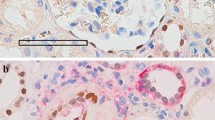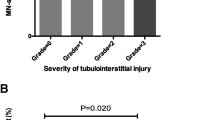Abstract
Background/aims
Recent studies have demonstrated that tubulointerstitial injury can predict renal outcomes better than the other histological parameters in patients with IgA nephropathy (IgAN). CD147 is a key regulator of renal tubulointerstitial fibrosis in cellular and animal models. However, it is not clear whether the expression of CD147 correlates with tubulointerstitial injury in IgAN patients.
Methods
We analyzed the degree of CD147 expression and localization in renal biopsy tissues from IgAN patients and correlated their immunostaining scores with clinical and histological parameters.
Results
Elevated CD147 expression was found in the basolateral membrane of renal tubules in IgAN patients; however, in normal kidney samples, positive staining for CD147 was not found in the tubular epithelial cells (P = 0.000). CD147 protein expression in the renal tubules showed a negative correlation with estimated glomerular filtration rate (eGFR; r = −0.600, P = 0.000) and a positive correlation with serum creatinine (Scr; r = 0.322, P = 0.002) and tubulointerstitial lesions (r = 0.525, P = 0.000). Moreover, a high level of CD147 correlated with the activation of Slug expression and E-cadherin repression in patients with IgAN. Kaplan–Meier survival curves showed that elevated CD147 expression was associated with decreased renal survival. Multivariate analyses further demonstrated that a high CD147 immunostaining score was an independent predictor of renal outcome in patients with IgAN (HR = 8.731, P = 0.041).
Conclusion
CD147 expression is associated with tubulointerstitial injury and predicts renal prognosis in IgA nephropathy. CD147 may be an early marker for tubulointerstitial injury IgA nephropathy.




Similar content being viewed by others
References
Berger J, Hinglais N (1968) Intercapillary deposits of IgA–IgG. J Urol Nephrol 74:694–695
Velo M, Lozano L, Egido J, Gutierrez-Millet V, Hernando L (1987) Natural history of IgA nephropathy in patients followed-up for more than ten years in Spain. Semin Nephrol 7:346–350
Lv J, Zhang H, Zhou Y, Li G, Zou W, Wang H (2008) Natural history of immunoglobulin A nephropathy and predictive factors of prognosis: a long-term follow up of 204 cases in China. Nephrology 13:242–246
D’Amico G (2004) Natural history of idiopathic IgA nephropathy and factors predictive of disease outcome. Semin Nephrol 24:179–196
Haas M (1997) Histologic subclassification of IgA nephropathy: a clinicopathologic study of 244 cases. Am J Kidney Dis 29:829–842
Katafuchi R, Oh Y, Hori K et al (1994) An important role of glomerular segmental lesions on progression of IgA nephropathy: a multivariate analysis. Clin Nephrol 41:191–198
Bartosik LP, Lajoie G, Sugar L, Cattran DC (2001) Predicting progression in IgA nephropathy. Am J Kidney Dis 38:728–735
Biswas C, Zhang Y, DeCastro R et al (1995) The human tumor cell-derived collagenase stimulatory factor (renamed EMMPRIN) is a member of the immunoglobulin superfamily. Cancer Res 55:434–439
Biswas C (1982) Tumor cell stimulation of collagenase production by fibroblasts. Biochem Biophys Res Commun 109:1026–1034
Yurchenko V, Constant S, Bukrinsky M (2006) Dealing with the family: CD147 interactions with cyclophilins. Immunology 117:301–309
Riethdorf S, Reimers N, Assmann V et al (2006) High incidence of EMMPRIN expression in human tumors. Int J Cancer 119:1800–1810
Kato N, Kosugi T, Sato W et al (2011) Basigin/CD147 promotes renal fibrosis after unilateral ureteral obstruction. Am J Pathol 178:572–579
Wu J, Ru NY, Zhang Y et al (2011) HAb18G/CD147 promotes epithelial-mesenchymal transition through TGF-β signaling and is transcriptionally regulated by Slug. Oncogene 30:4410–4427
Tan Y, Zhang JJ, Liu G, Zhang H, Zhao MH (2009) The level of urinary secretory immunoglobulin A (sIgA) of patients with IgA nephropathy is elevated and associated with pathological phenotypes. Clin Exp Immunol 156:111–116
Higgins DF, Kimura K, Bernhardt WM et al (2007) Hypoxia promotes fibrogenesis in vivo via HIF-1 stimulation of epithelial-to-mesenchymal transition. J Clin Invest 117:3810–3820
Roufosse CA, Cook HT (2009) Pathological predictors of prognosis in immunoglobulin A nephropathy: a review. Curr Opin Nephrol Hypertens 18:212–219
Lee HS, Lee MS, Lee SM et al (2005) Histological grading of IgA nephropathy predicting renal outcome: revisiting H. S. Lee’s glomerular grading system. Nephrol Dial Transplant 20:342–348
Radford MG Jr, Donadio JV Jr, Bergstralh EJ, Grande JP (1997) Predicting renal outcome in IgA nephropathy. J Am Soc Nephrol 8:199–207
Shackel NA, McGuinness PH, Abbott CA, Gorrell MD, McCaughan GW (2002) Insights into the pathobiology of hepatitis C virus-associated cirrhosis: analysis of intrahepatic differential gene expression. Am J Pathol 160:641–654
Guillot S, Delaval P, Brinchault G et al (2006) Increased extracellular matrix metalloproteinase inducer (EMMPRIN) expression in pulmonary fibrosis. Exp Lung Res 32:81–97
Wang CH, Yao H, Chen LN et al (2012) CD147 induces angiogenesis through a vascular endothelial growth factor and hypoxia-inducible transcription factor 1alpha-mediated pathway in rheumatoid arthritis. Arthritis Rheum 64:1818–1827
Shimada M, Yamabe H, Osawa H et al (2009) Extracellular matrix metalloproteinase inducer is expressed in the proximal tubular epithelial cells of the human kidney. Nephrology 14:171–178
Huet E, Vallée B, Szul D et al (2008) Extracellular matrix metalloproteinase inducer/CD147 promotes myofibroblast differentiation by inducing alpha-smooth muscle actin expression and collagen gel contraction: implications in tissue remodeling. FASEB J 22:1144–1154
Acknowledgments
This work was partially supported by grants from the National Nature Science Foundation of China (Nos. 81070570, 81170670 and 81100525).
Conflict of interest
The authors state that there are no conflicts of interest to disclose.
Author information
Authors and Affiliations
Corresponding author
Additional information
S. Sun and A. Zhao contributed equally to this work.
Rights and permissions
About this article
Cite this article
Sun, S., Zhao, A., Li, R. et al. CD147 renal expression as a biomarker for progressive IgAN. J Nephrol 28, 307–314 (2015). https://doi.org/10.1007/s40620-014-0161-1
Received:
Accepted:
Published:
Issue Date:
DOI: https://doi.org/10.1007/s40620-014-0161-1




